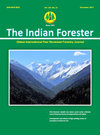Ecosystem Goods and Services Provided by 'Beels' in Kaziranga
DOI:
https://doi.org/10.36808/if/2017/v143i12/120380Keywords:
Ecological Goods and Services, Beels, Wetlands, Ecosystem, Protected Area.Abstract
The Kaziranga National Park is an important protected Area in Assam having 6% of its geographical area under 'beels' or wetlands. Earlier studies have suggested that the number of 'beels' and their extent in the Park has reduced significantly over a period of time. The reasons for such reduction have been attributed to siltation, weed invasion, pollution, anthropogenic interventions and degradation of catchments. 'beels' being one of the important habitats in the Park, their degradation has become an issue of concern. During this study, six 'beels' inside and four outside the Park were studied to examine the ecological goods and services provided by them. It was found that all 'beels' inside the protected area provide forage to the wildlife through the productivity of wetlands and various associated habitats in a matrix of short grasslands, tall grasslands and surrounding woodlands. 'beels' outside the park are offering goods to the community in terms of fish, plant products, grazing grounds for cattle, source of water for irrigation and rich alluvium for agriculture. The 'beels' inside, though having significant biodiversity values, are not accessible for consumptive benefits being inside a protected area. However, they perform several important ecosystem functions crucial for the protected area biodiversity and human well being in the adjoining areas such as recharging ground water, trapping silt, reducing intensity of the floods and have great aesthetic value in terms of tourism for the society at large. Thus, the 'beels' of Kaziranga are providing provisioning, regulating, supporting, cultural and preserving services. 'beels' both inside and outside the park need to be restored and maintained through appropriate mechanism so as to derive sustainable benefits from this ecosystem, both for the Protected Area and the surrounding landscape's dependent human society.References
Barmon B.K., Kondo T. and Osanami F. (2006). Laboratory of Development Economics, Department of Agricultural Economics, Graduate School of Agriculture, Hokkaido University, Japan. Economic Evaluation of Rice-Prawn Gher Farming System on Soil Fertility for Modern Variety (MV) Paddy Production in Bangladesh. Contributed paper prepared for presentation at the International Association of Agricultural Economists Conference, Gold Coast, Australia, August 12-18, 2006.
Daily G.C.(1997). Nature's services- Societal dependence on Natural Ecosystems. Island Press. Washington,D.C. Covelo, California. Pp.3, 11.
http://en.wikipedia.org/wiki/Beel (accessed on 25.3.08) Beel from Wikipedia the free encyclopedia.
http://en.wikipedia.org/wiki/Ecological_goods_and_services (accessed on 25.3.08) Ecological Goods and Services from Wikipedia, the free encyclopedia.
MEA (2005). Millennium Ecosystem Assessment. Ecosystems and Human Well-Being: Synthesis. Island Press, Washington. 155pp.
Mitsch W.J. and Gosselink J.G. (2000). Wetlands. 3rd edn. John Wiley and Sons Inc., New York.
Balakrishnan P. (2005). Ecological characteristics of 'beels' in Kaziranga NP and their role in conservation of waterfowl. P.G.Diploma Term paper dissertation . Wildlife Institute of India, Dehradun.
Vasu N.K. (2002). Management plan of Kaziranga National Park. (2003-04 to 2012-13).
Downloads
Downloads
Published
How to Cite
Issue
Section
License
Unless otherwise stated, copyright or similar rights in all materials presented on the site, including graphical images, are owned by Indian Forester.





